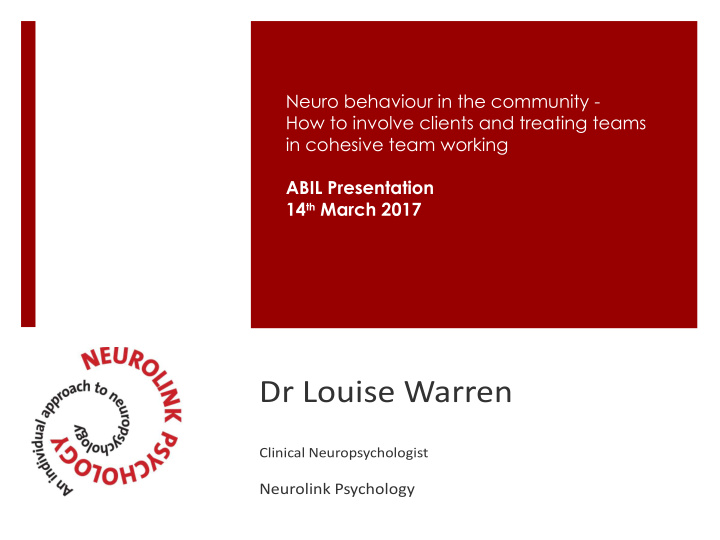



Neuro behaviour in the community - How to involve clients and treating teams in cohesive team working ABIL Presentation 14 th March 2017 D r L o u i s e W a r r e n C l i n i c a l N e u r o p s y c h o l o g i s t N e u r o l i n k P s y c h o l o g y
Objectives Describe emotional self control Impact on everyday life in the community Vignette Multi-factorial formulation of inappropriate laughter in the community Intervention approaches Narratives – treating team beliefs & individual differences Where is the joy? Transformation Conclusions
What to consider? Family system Freedom and Fears contaminating opportunities progress Cognitive profile Support Workers influence Mood Neuro Influence of social Behaviour in the media Team narrative e.g. hope/ non risk taking Community Insight Clients identity “do I Social Context – look brain injured” functioning social, work, relationships Medication changes Social Rules Sexuality & desire
The mechanics of emotional self control Emotional regulation “the process by which people influence their emotional experience and expression” (Gross, 1998) Link to understanding of self-control over affective processes. Explicit & intentional OR implicit & unintentional. Focus on clients who are required to actively regulate their emotional experiences and expressions.
Important structures to consider Right Ventro-Lateral Pre Frontal Cortex (rVLPFC)- self control and emotional suppression. Other prefrontal regions Medial PFC Anterior Cingulate Cortex (ACC) Dorso Lateral PFC Subcortical structures including amygdala Sometimes Left VLPFC active but not as often as right.
Emotional processes Emotional Reactivity Subjective experience Behaviour Peripheral Antecedent Appraisal physiology Emotional Regulation Response- Antecedent- focussed focussed (“Suppression”) (“Reappraisal”) Empathy Cognitive Emotional Prosocial (recognising (responding to (helping others emotions) emotions) in distress)
Impact on everyday life Community goals – Voluntary work or employment Maintaining and forming relationships and friendships Leisure activities e.g. gym, book clubs, restaurants, night clubs Shopping Longevity, needing to cope in the long term Behaviour does not happen in isolation Sudden behaviour change
Intervention Identification of bodily sensations Labelling of emotions Cognitive appraisals Antecedent focused vs Response-focused Individual work plus team involvement Client involvement in the writing of guidelines. Situational feedback e.g. others smiling or not. How to transfer learning from consulting room to community
Importance of cognitive appraisals Acquired brain injury can predispose to seeing others behaviour as intentional or hostile (Neumann et al. 2016) Can increase likelihood of angry responses. Cognitive Bias “They can tell I’ve got a brain injury” Attentional focus on self rather than situation and others. Intervention - target the bias first.
Inappropriate comments What the social rules are for a situation or setting or relationship or friendship How to and when to inhibit saying something or doing something which might be inappropriate. Difficulty reading facial expressions/voice tone change Difficulty recognising jokes/sarcasm Understanding of non-verbals/gesture
Prevention & Management Train support workers in exploring cognitive appraisals. Based on a trusting working alliance Use individual sessions to model to support workers Train support workers to explore bodily sensations, thoughts and feelings. Yellow/red card system for clear identification of inappropriate behaviour. Used specifically. Training provided to support workers to debrief client. Link to life goals. Outcome
Key Considerations Sense of agency Monitor Support Role play training Worker records with support workers – compassionate focus Behaviour is separate Targeting Compassion to the client Behaviour in the focussed Approach (narrative principles) community - reduced activation of threat related thoughts Hope Agree formulation Reward system in And treatment plan place with client Legal consequences
Risk in the community Legal issues Impact on ability to stay in the country Causing offence to general public Risk of harm to self or others due to aggravating others or behaviour causing distress. Impact on daily activities, work, leisure, relationships.
How can we enable change in the community? Clear link to longer term goals e.g. marriage/family/job. Use steps to achievement. Goals written in clients words e.g. “I would like to go on a date, more than one with the same person” “I would like to have a conversation with a group of people in the pub without laughing at the wrong time”. Small cohesive support worker team. Support Worker training by treating team, and ongoing coaching. Clear formulation shared with team. Clear guidance provided to team to ensure consistent approach.
Narratives within the treating team Gender, cultural and many other differences in treating team impact expectations and appraisals of behaviour and communication(use of supervision) Fear of taking risks and limit setting – potential worst case scenario outcomes (risk assessments)
Transformation How much can we accept change in behaviour? Can we embrace any elements of the consequences of TBI? Overwhelming joy – emotional dysregulation and happiness….is this a transformation I don’t want to change? Collaborative working with clients. Redefining the self/emergence of a new self post TBI Identifying the purpose of being
Conclusions Activation of compassionate emotions Importance of cognitive appraisals. Antecedent control plus emotional recognition Close intensive team working Client sense of agency Ongoing collaborative formulation Link to life goals
Literature Compassion Focused Therapy After Traumatic Brain Injury: Theoretical Foundations and a Case Illustration. Ashworth, F; Gracey, F & Gilbert, P. (2011) Brain Impairment 12 (2) pp.128- 139. The Influence of Personal Emotional Awareness on Aggression After Brain Injury. Neumann, D. Hammond, F., Malec, J. (2016) Archives of Physical Medicine and Rehabilitation 97 (10), p.23. Rebuilding Identity Through Narrative Following TBI by Morris, S.D. (2004) The Journal of Cognitive Rehabilitation pp. 15-21 Principles of Frontal Lobe Function (2 nd Edition) Edited by Stuss, D.T. & Knight, R.T. (2013).
Questions ? Neurolink Psychology 10 Harley Street London W1G 9PF Tel: 0207 467 1509 Dr.Warren@neurolinkpsych.co.uk
Recommend
More recommend